Comprehensive Analysis of Nestle's Business Environment and Strategies
VerifiedAdded on 2021/01/01
|10
|2975
|131
Report
AI Summary
This report provides a comprehensive analysis of Nestle's business environment, examining both internal and external factors. It begins with an introduction to the business environment and its dynamic nature, emphasizing the influence of various forces like customers, competitors, and governmental regulations. The report then delves into Nestle's organizational structure, exploring the interrelation between different departments such as human resources, marketing, finance, and production, and their links to organizational objectives. It highlights the importance of these functions in achieving predetermined goals. The report also analyzes the impact of macro-environmental factors, including political, economic, social, technological, legal, and environmental factors, on Nestle's operations. Furthermore, it conducts an internal analysis to identify the company's strengths and weaknesses, as well as the opportunities and threats it faces. Finally, the report examines the interrelation between macro-environmental factors and organizational strengths and weaknesses, using PESTEL analysis to define positive and negative impacts, and providing insights into how Nestle can formulate effective strategies to thrive in the competitive global market.

Business and Business
Environment
Environment
Paraphrase This Document
Need a fresh take? Get an instant paraphrase of this document with our AI Paraphraser

Table of Contents
INTRODUCTION...........................................................................................................................1
TASK 1............................................................................................................................................1
P1 & P2 (Covered in PPT)....................................................................................................1
TASK 2............................................................................................................................................1
P3 Interrelation between different organisational departments and their link to objectives. .1
TASK 3............................................................................................................................................3
P4 Impact of macro-environmental factors............................................................................3
TASK 4............................................................................................................................................5
P5 Internal analysis of organisation for identification of strength and weaknesses...............5
P6 Interrelation of macro-environmental factors with organisational strength and weaknesses 6
CONCLUSION................................................................................................................................7
REFRENCES...................................................................................................................................8
INTRODUCTION...........................................................................................................................1
TASK 1............................................................................................................................................1
P1 & P2 (Covered in PPT)....................................................................................................1
TASK 2............................................................................................................................................1
P3 Interrelation between different organisational departments and their link to objectives. .1
TASK 3............................................................................................................................................3
P4 Impact of macro-environmental factors............................................................................3
TASK 4............................................................................................................................................5
P5 Internal analysis of organisation for identification of strength and weaknesses...............5
P6 Interrelation of macro-environmental factors with organisational strength and weaknesses 6
CONCLUSION................................................................................................................................7
REFRENCES...................................................................................................................................8

INTRODUCTION
Businesses environment consist various external or internal factors which have great
influence on their function. It covers entire forces such as customers, suppliers, competitors,
government, cultural, political, legal conditions and technological. The business environment is
dynamic in its nature so that it always keep on changing as per the situations. It closely related
with all external forces which are beyond the control from management and affects on the
business functions or operations in various ways. It is necessary to formulate effective strategies
and make favourable decisions so that company can survive in the competitive environment as
well as achieve predetermined goals or objectives in an effective manner (Reed, 2013). This
report is based on Nestle which is Swiss transnational food and drinks company. It is dealing in
various goods such as ice cream, frozen food, Kit-Kat, Smarties, Maggie, tea, baby and medical
food, confectionery and dairy products etc. it will define different types and purpose of
organisation as public, private and voluntary sector with size or scope. It will explain relationship
between organisational functions with objectives. It identify positive or negative impacts of
macro-environment and conduct internal or external analysis for identify strengths or weaknesses
interrelate with external macro forces within organisation.
TASK 1
P1 & P2 (Covered in PPT)
TASK 2
P3 Interrelation between different organisational departments and their link to objectives
There are number of functions and activities defined in every organisations that must be
performed by the management for the purpose of achieving predetermined goals or objectives
(Osterwalder, 2010). It consist necessary functions that interlinked with organisational
department so that company can accomplish its set targets or goals through improving internal
strengths as well. It included various department of Nestle such as human resources, IT,
production and operations,s finance and accounting to attain bests possible outcomes. These are
as following:
Human resource department: It is defined as the functions or activity that every
organisation perform in well manner because this must be required to get work done by
1
Businesses environment consist various external or internal factors which have great
influence on their function. It covers entire forces such as customers, suppliers, competitors,
government, cultural, political, legal conditions and technological. The business environment is
dynamic in its nature so that it always keep on changing as per the situations. It closely related
with all external forces which are beyond the control from management and affects on the
business functions or operations in various ways. It is necessary to formulate effective strategies
and make favourable decisions so that company can survive in the competitive environment as
well as achieve predetermined goals or objectives in an effective manner (Reed, 2013). This
report is based on Nestle which is Swiss transnational food and drinks company. It is dealing in
various goods such as ice cream, frozen food, Kit-Kat, Smarties, Maggie, tea, baby and medical
food, confectionery and dairy products etc. it will define different types and purpose of
organisation as public, private and voluntary sector with size or scope. It will explain relationship
between organisational functions with objectives. It identify positive or negative impacts of
macro-environment and conduct internal or external analysis for identify strengths or weaknesses
interrelate with external macro forces within organisation.
TASK 1
P1 & P2 (Covered in PPT)
TASK 2
P3 Interrelation between different organisational departments and their link to objectives
There are number of functions and activities defined in every organisations that must be
performed by the management for the purpose of achieving predetermined goals or objectives
(Osterwalder, 2010). It consist necessary functions that interlinked with organisational
department so that company can accomplish its set targets or goals through improving internal
strengths as well. It included various department of Nestle such as human resources, IT,
production and operations,s finance and accounting to attain bests possible outcomes. These are
as following:
Human resource department: It is defined as the functions or activity that every
organisation perform in well manner because this must be required to get work done by
1
⊘ This is a preview!⊘
Do you want full access?
Subscribe today to unlock all pages.

Trusted by 1+ million students worldwide

managing manpower or employees performances in an effective way. HR department perform
number of activities such as recruiting and selecting best suitable candidates who have ability to
accomplish targets or goals. They also consider other important activities such as performance
appraisals, remuneration or rewards systems, training and development programs etc. Nestle
gives first priority to the workforce because if employees are not satisfied than it will be difficult
to achieve objectives.
Marketings department: This is very important department which play vital role in
creating demands and increasing sales volume so that better position can be occupied by the
organisation. Manager focus on adopting best tool or promotional techniques so that huge
customers can be attracted and also create awareness among them (Pigneur, 2010). Nestle
conducts research or survey to identify customers needs or demands, competitors,s market trend,
situations etc. for producing best goods and satisfy customers desired expectations.
Finance department: It play an important role in performing every tasks or activities in
an effective way as manager provide adequate funds financial services to entire activities so that
particular goals or targets can be achieved within define time period. Without funding, it is not
possible to complete whole tasks and runs business operations. Therefore, it is also known as
backbone of business.
Production department: this department is directly linked with marketings department
as they provide proper information and data regarding marketing trends and customers demands
so that company make decision about production of goods and services in an effective manner.
Nestle also does the same and get information about customer's tastes, preferences as well as
desired expectations towards goods or services.
Organisational structure
Function based: It is considered as the organisational structure that based on business
functions (Pikka, 2011). These are very important for every organisations for
achieving success as it included human resource, finance functions, sales and
marketing, IT etc.
Geography based: In this consider the segmentation as company divide its entire
functions or activities as per the classification of people or areas such as hilly, region,
rural or urban etc. for reaching at targeted audiences.
2
number of activities such as recruiting and selecting best suitable candidates who have ability to
accomplish targets or goals. They also consider other important activities such as performance
appraisals, remuneration or rewards systems, training and development programs etc. Nestle
gives first priority to the workforce because if employees are not satisfied than it will be difficult
to achieve objectives.
Marketings department: This is very important department which play vital role in
creating demands and increasing sales volume so that better position can be occupied by the
organisation. Manager focus on adopting best tool or promotional techniques so that huge
customers can be attracted and also create awareness among them (Pigneur, 2010). Nestle
conducts research or survey to identify customers needs or demands, competitors,s market trend,
situations etc. for producing best goods and satisfy customers desired expectations.
Finance department: It play an important role in performing every tasks or activities in
an effective way as manager provide adequate funds financial services to entire activities so that
particular goals or targets can be achieved within define time period. Without funding, it is not
possible to complete whole tasks and runs business operations. Therefore, it is also known as
backbone of business.
Production department: this department is directly linked with marketings department
as they provide proper information and data regarding marketing trends and customers demands
so that company make decision about production of goods and services in an effective manner.
Nestle also does the same and get information about customer's tastes, preferences as well as
desired expectations towards goods or services.
Organisational structure
Function based: It is considered as the organisational structure that based on business
functions (Pikka, 2011). These are very important for every organisations for
achieving success as it included human resource, finance functions, sales and
marketing, IT etc.
Geography based: In this consider the segmentation as company divide its entire
functions or activities as per the classification of people or areas such as hilly, region,
rural or urban etc. for reaching at targeted audiences.
2
Paraphrase This Document
Need a fresh take? Get an instant paraphrase of this document with our AI Paraphraser
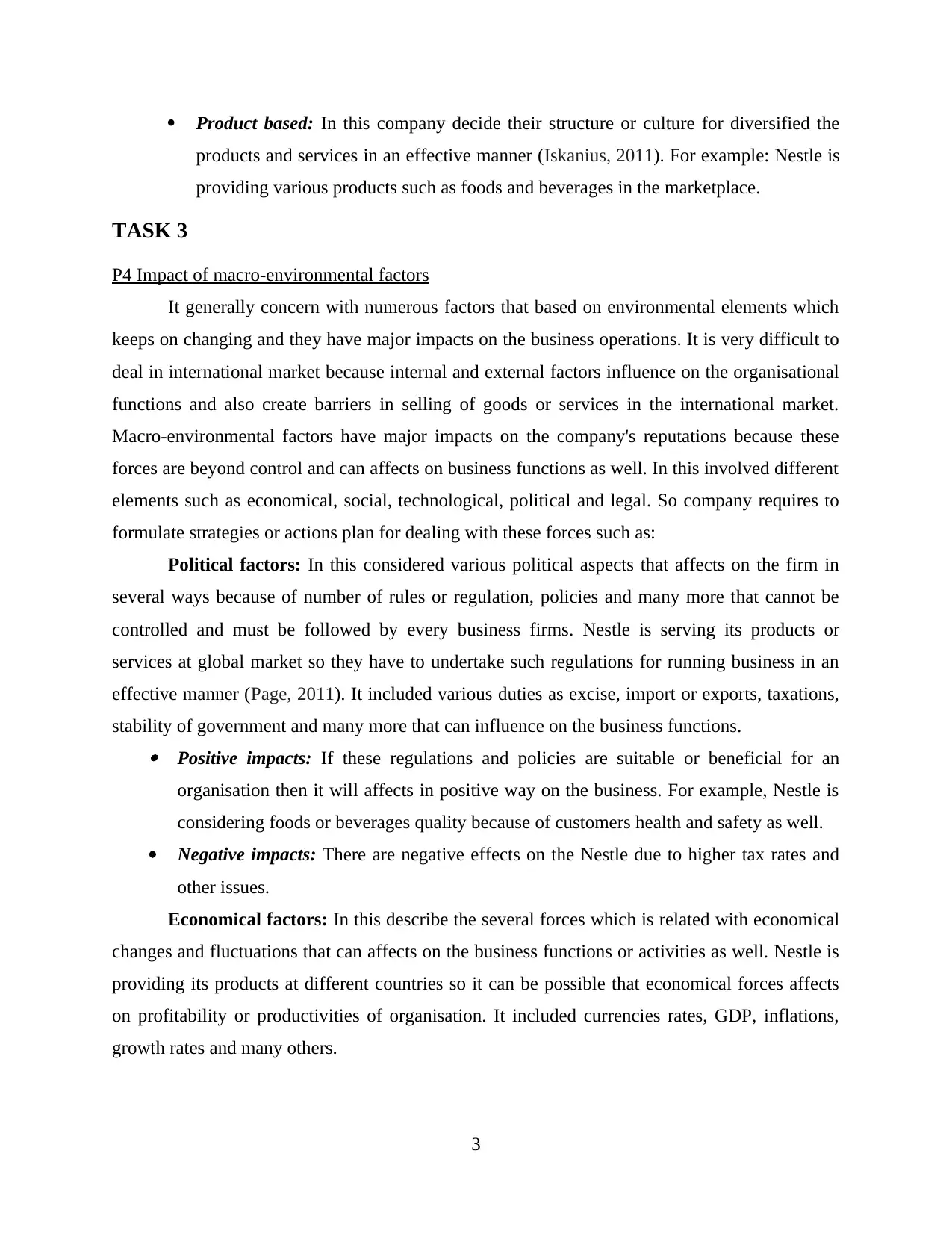
Product based: In this company decide their structure or culture for diversified the
products and services in an effective manner (Iskanius, 2011). For example: Nestle is
providing various products such as foods and beverages in the marketplace.
TASK 3
P4 Impact of macro-environmental factors
It generally concern with numerous factors that based on environmental elements which
keeps on changing and they have major impacts on the business operations. It is very difficult to
deal in international market because internal and external factors influence on the organisational
functions and also create barriers in selling of goods or services in the international market.
Macro-environmental factors have major impacts on the company's reputations because these
forces are beyond control and can affects on business functions as well. In this involved different
elements such as economical, social, technological, political and legal. So company requires to
formulate strategies or actions plan for dealing with these forces such as:
Political factors: In this considered various political aspects that affects on the firm in
several ways because of number of rules or regulation, policies and many more that cannot be
controlled and must be followed by every business firms. Nestle is serving its products or
services at global market so they have to undertake such regulations for running business in an
effective manner (Page, 2011). It included various duties as excise, import or exports, taxations,
stability of government and many more that can influence on the business functions. Positive impacts: If these regulations and policies are suitable or beneficial for an
organisation then it will affects in positive way on the business. For example, Nestle is
considering foods or beverages quality because of customers health and safety as well.
Negative impacts: There are negative effects on the Nestle due to higher tax rates and
other issues.
Economical factors: In this describe the several forces which is related with economical
changes and fluctuations that can affects on the business functions or activities as well. Nestle is
providing its products at different countries so it can be possible that economical forces affects
on profitability or productivities of organisation. It included currencies rates, GDP, inflations,
growth rates and many others.
3
products and services in an effective manner (Iskanius, 2011). For example: Nestle is
providing various products such as foods and beverages in the marketplace.
TASK 3
P4 Impact of macro-environmental factors
It generally concern with numerous factors that based on environmental elements which
keeps on changing and they have major impacts on the business operations. It is very difficult to
deal in international market because internal and external factors influence on the organisational
functions and also create barriers in selling of goods or services in the international market.
Macro-environmental factors have major impacts on the company's reputations because these
forces are beyond control and can affects on business functions as well. In this involved different
elements such as economical, social, technological, political and legal. So company requires to
formulate strategies or actions plan for dealing with these forces such as:
Political factors: In this considered various political aspects that affects on the firm in
several ways because of number of rules or regulation, policies and many more that cannot be
controlled and must be followed by every business firms. Nestle is serving its products or
services at global market so they have to undertake such regulations for running business in an
effective manner (Page, 2011). It included various duties as excise, import or exports, taxations,
stability of government and many more that can influence on the business functions. Positive impacts: If these regulations and policies are suitable or beneficial for an
organisation then it will affects in positive way on the business. For example, Nestle is
considering foods or beverages quality because of customers health and safety as well.
Negative impacts: There are negative effects on the Nestle due to higher tax rates and
other issues.
Economical factors: In this describe the several forces which is related with economical
changes and fluctuations that can affects on the business functions or activities as well. Nestle is
providing its products at different countries so it can be possible that economical forces affects
on profitability or productivities of organisation. It included currencies rates, GDP, inflations,
growth rates and many others.
3
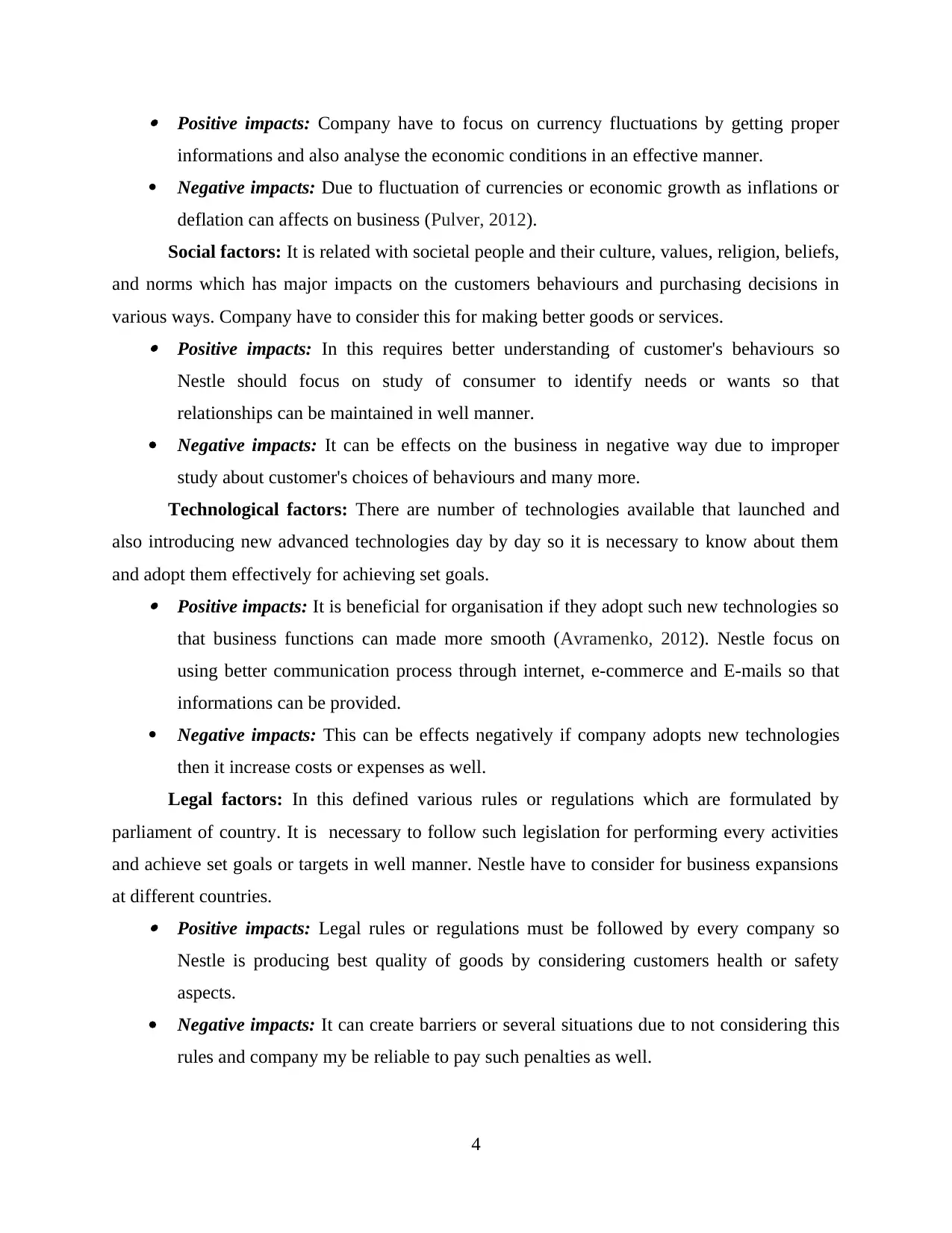
Positive impacts: Company have to focus on currency fluctuations by getting proper
informations and also analyse the economic conditions in an effective manner.
Negative impacts: Due to fluctuation of currencies or economic growth as inflations or
deflation can affects on business (Pulver, 2012).
Social factors: It is related with societal people and their culture, values, religion, beliefs,
and norms which has major impacts on the customers behaviours and purchasing decisions in
various ways. Company have to consider this for making better goods or services. Positive impacts: In this requires better understanding of customer's behaviours so
Nestle should focus on study of consumer to identify needs or wants so that
relationships can be maintained in well manner.
Negative impacts: It can be effects on the business in negative way due to improper
study about customer's choices of behaviours and many more.
Technological factors: There are number of technologies available that launched and
also introducing new advanced technologies day by day so it is necessary to know about them
and adopt them effectively for achieving set goals. Positive impacts: It is beneficial for organisation if they adopt such new technologies so
that business functions can made more smooth (Avramenko, 2012). Nestle focus on
using better communication process through internet, e-commerce and E-mails so that
informations can be provided.
Negative impacts: This can be effects negatively if company adopts new technologies
then it increase costs or expenses as well.
Legal factors: In this defined various rules or regulations which are formulated by
parliament of country. It is necessary to follow such legislation for performing every activities
and achieve set goals or targets in well manner. Nestle have to consider for business expansions
at different countries. Positive impacts: Legal rules or regulations must be followed by every company so
Nestle is producing best quality of goods by considering customers health or safety
aspects.
Negative impacts: It can create barriers or several situations due to not considering this
rules and company my be reliable to pay such penalties as well.
4
informations and also analyse the economic conditions in an effective manner.
Negative impacts: Due to fluctuation of currencies or economic growth as inflations or
deflation can affects on business (Pulver, 2012).
Social factors: It is related with societal people and their culture, values, religion, beliefs,
and norms which has major impacts on the customers behaviours and purchasing decisions in
various ways. Company have to consider this for making better goods or services. Positive impacts: In this requires better understanding of customer's behaviours so
Nestle should focus on study of consumer to identify needs or wants so that
relationships can be maintained in well manner.
Negative impacts: It can be effects on the business in negative way due to improper
study about customer's choices of behaviours and many more.
Technological factors: There are number of technologies available that launched and
also introducing new advanced technologies day by day so it is necessary to know about them
and adopt them effectively for achieving set goals. Positive impacts: It is beneficial for organisation if they adopt such new technologies so
that business functions can made more smooth (Avramenko, 2012). Nestle focus on
using better communication process through internet, e-commerce and E-mails so that
informations can be provided.
Negative impacts: This can be effects negatively if company adopts new technologies
then it increase costs or expenses as well.
Legal factors: In this defined various rules or regulations which are formulated by
parliament of country. It is necessary to follow such legislation for performing every activities
and achieve set goals or targets in well manner. Nestle have to consider for business expansions
at different countries. Positive impacts: Legal rules or regulations must be followed by every company so
Nestle is producing best quality of goods by considering customers health or safety
aspects.
Negative impacts: It can create barriers or several situations due to not considering this
rules and company my be reliable to pay such penalties as well.
4
⊘ This is a preview!⊘
Do you want full access?
Subscribe today to unlock all pages.

Trusted by 1+ million students worldwide
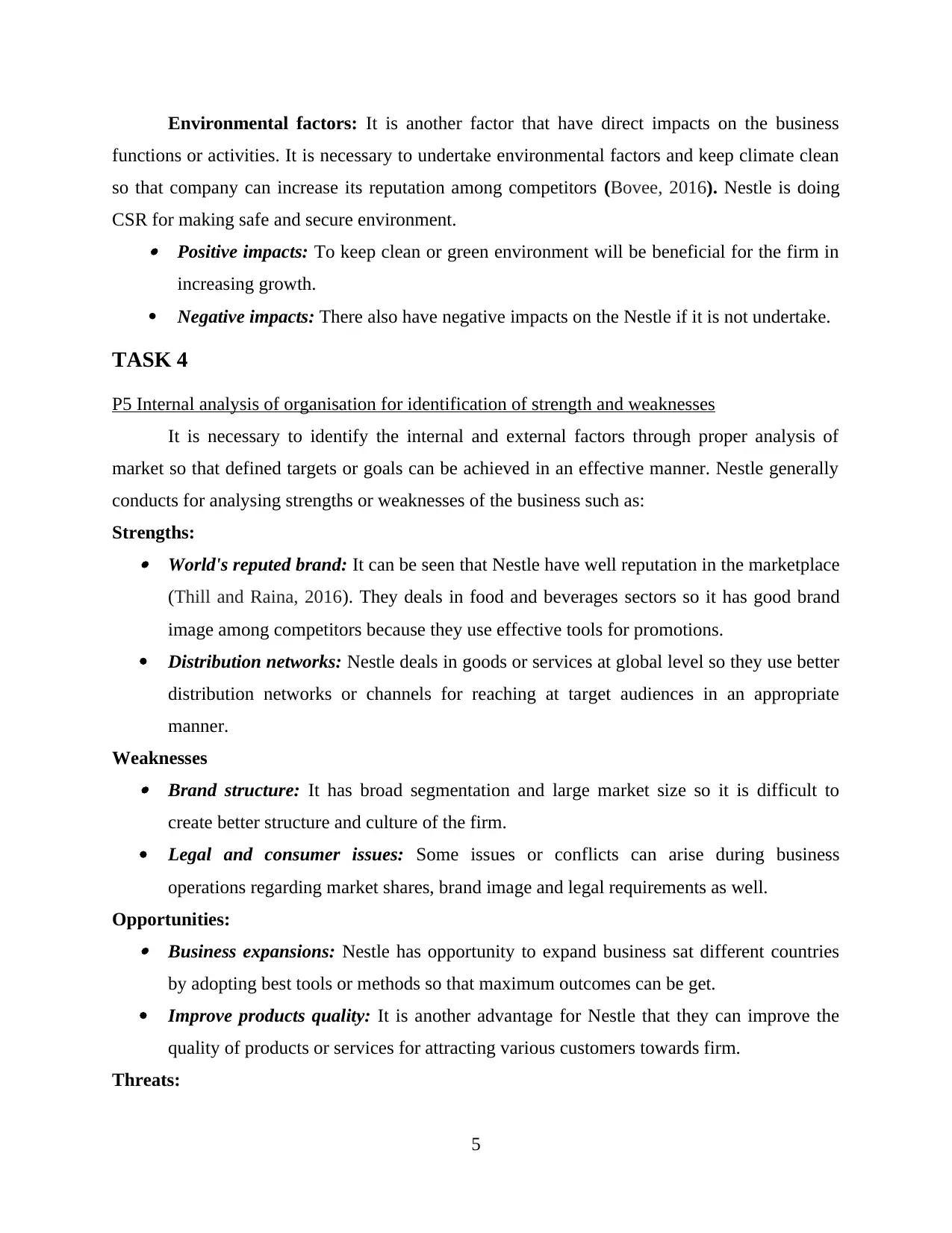
Environmental factors: It is another factor that have direct impacts on the business
functions or activities. It is necessary to undertake environmental factors and keep climate clean
so that company can increase its reputation among competitors (Bovee, 2016). Nestle is doing
CSR for making safe and secure environment. Positive impacts: To keep clean or green environment will be beneficial for the firm in
increasing growth.
Negative impacts: There also have negative impacts on the Nestle if it is not undertake.
TASK 4
P5 Internal analysis of organisation for identification of strength and weaknesses
It is necessary to identify the internal and external factors through proper analysis of
market so that defined targets or goals can be achieved in an effective manner. Nestle generally
conducts for analysing strengths or weaknesses of the business such as:
Strengths: World's reputed brand: It can be seen that Nestle have well reputation in the marketplace
(Thill and Raina, 2016). They deals in food and beverages sectors so it has good brand
image among competitors because they use effective tools for promotions.
Distribution networks: Nestle deals in goods or services at global level so they use better
distribution networks or channels for reaching at target audiences in an appropriate
manner.
Weaknesses Brand structure: It has broad segmentation and large market size so it is difficult to
create better structure and culture of the firm.
Legal and consumer issues: Some issues or conflicts can arise during business
operations regarding market shares, brand image and legal requirements as well.
Opportunities: Business expansions: Nestle has opportunity to expand business sat different countries
by adopting best tools or methods so that maximum outcomes can be get.
Improve products quality: It is another advantage for Nestle that they can improve the
quality of products or services for attracting various customers towards firm.
Threats:
5
functions or activities. It is necessary to undertake environmental factors and keep climate clean
so that company can increase its reputation among competitors (Bovee, 2016). Nestle is doing
CSR for making safe and secure environment. Positive impacts: To keep clean or green environment will be beneficial for the firm in
increasing growth.
Negative impacts: There also have negative impacts on the Nestle if it is not undertake.
TASK 4
P5 Internal analysis of organisation for identification of strength and weaknesses
It is necessary to identify the internal and external factors through proper analysis of
market so that defined targets or goals can be achieved in an effective manner. Nestle generally
conducts for analysing strengths or weaknesses of the business such as:
Strengths: World's reputed brand: It can be seen that Nestle have well reputation in the marketplace
(Thill and Raina, 2016). They deals in food and beverages sectors so it has good brand
image among competitors because they use effective tools for promotions.
Distribution networks: Nestle deals in goods or services at global level so they use better
distribution networks or channels for reaching at target audiences in an appropriate
manner.
Weaknesses Brand structure: It has broad segmentation and large market size so it is difficult to
create better structure and culture of the firm.
Legal and consumer issues: Some issues or conflicts can arise during business
operations regarding market shares, brand image and legal requirements as well.
Opportunities: Business expansions: Nestle has opportunity to expand business sat different countries
by adopting best tools or methods so that maximum outcomes can be get.
Improve products quality: It is another advantage for Nestle that they can improve the
quality of products or services for attracting various customers towards firm.
Threats:
5
Paraphrase This Document
Need a fresh take? Get an instant paraphrase of this document with our AI Paraphraser
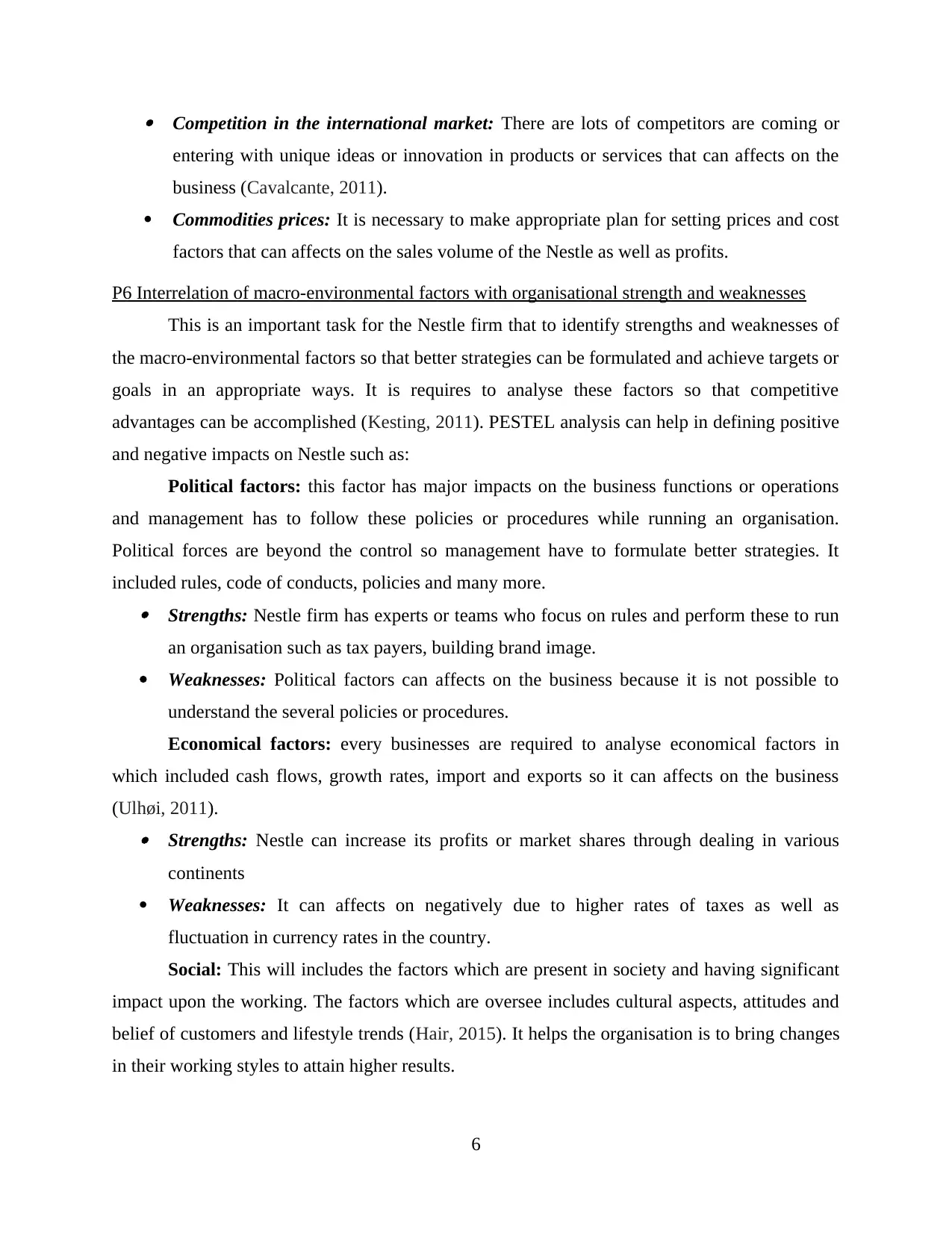
Competition in the international market: There are lots of competitors are coming or
entering with unique ideas or innovation in products or services that can affects on the
business (Cavalcante, 2011).
Commodities prices: It is necessary to make appropriate plan for setting prices and cost
factors that can affects on the sales volume of the Nestle as well as profits.
P6 Interrelation of macro-environmental factors with organisational strength and weaknesses
This is an important task for the Nestle firm that to identify strengths and weaknesses of
the macro-environmental factors so that better strategies can be formulated and achieve targets or
goals in an appropriate ways. It is requires to analyse these factors so that competitive
advantages can be accomplished (Kesting, 2011). PESTEL analysis can help in defining positive
and negative impacts on Nestle such as:
Political factors: this factor has major impacts on the business functions or operations
and management has to follow these policies or procedures while running an organisation.
Political forces are beyond the control so management have to formulate better strategies. It
included rules, code of conducts, policies and many more. Strengths: Nestle firm has experts or teams who focus on rules and perform these to run
an organisation such as tax payers, building brand image.
Weaknesses: Political factors can affects on the business because it is not possible to
understand the several policies or procedures.
Economical factors: every businesses are required to analyse economical factors in
which included cash flows, growth rates, import and exports so it can affects on the business
(Ulhøi, 2011). Strengths: Nestle can increase its profits or market shares through dealing in various
continents
Weaknesses: It can affects on negatively due to higher rates of taxes as well as
fluctuation in currency rates in the country.
Social: This will includes the factors which are present in society and having significant
impact upon the working. The factors which are oversee includes cultural aspects, attitudes and
belief of customers and lifestyle trends (Hair, 2015). It helps the organisation is to bring changes
in their working styles to attain higher results.
6
entering with unique ideas or innovation in products or services that can affects on the
business (Cavalcante, 2011).
Commodities prices: It is necessary to make appropriate plan for setting prices and cost
factors that can affects on the sales volume of the Nestle as well as profits.
P6 Interrelation of macro-environmental factors with organisational strength and weaknesses
This is an important task for the Nestle firm that to identify strengths and weaknesses of
the macro-environmental factors so that better strategies can be formulated and achieve targets or
goals in an appropriate ways. It is requires to analyse these factors so that competitive
advantages can be accomplished (Kesting, 2011). PESTEL analysis can help in defining positive
and negative impacts on Nestle such as:
Political factors: this factor has major impacts on the business functions or operations
and management has to follow these policies or procedures while running an organisation.
Political forces are beyond the control so management have to formulate better strategies. It
included rules, code of conducts, policies and many more. Strengths: Nestle firm has experts or teams who focus on rules and perform these to run
an organisation such as tax payers, building brand image.
Weaknesses: Political factors can affects on the business because it is not possible to
understand the several policies or procedures.
Economical factors: every businesses are required to analyse economical factors in
which included cash flows, growth rates, import and exports so it can affects on the business
(Ulhøi, 2011). Strengths: Nestle can increase its profits or market shares through dealing in various
continents
Weaknesses: It can affects on negatively due to higher rates of taxes as well as
fluctuation in currency rates in the country.
Social: This will includes the factors which are present in society and having significant
impact upon the working. The factors which are oversee includes cultural aspects, attitudes and
belief of customers and lifestyle trends (Hair, 2015). It helps the organisation is to bring changes
in their working styles to attain higher results.
6
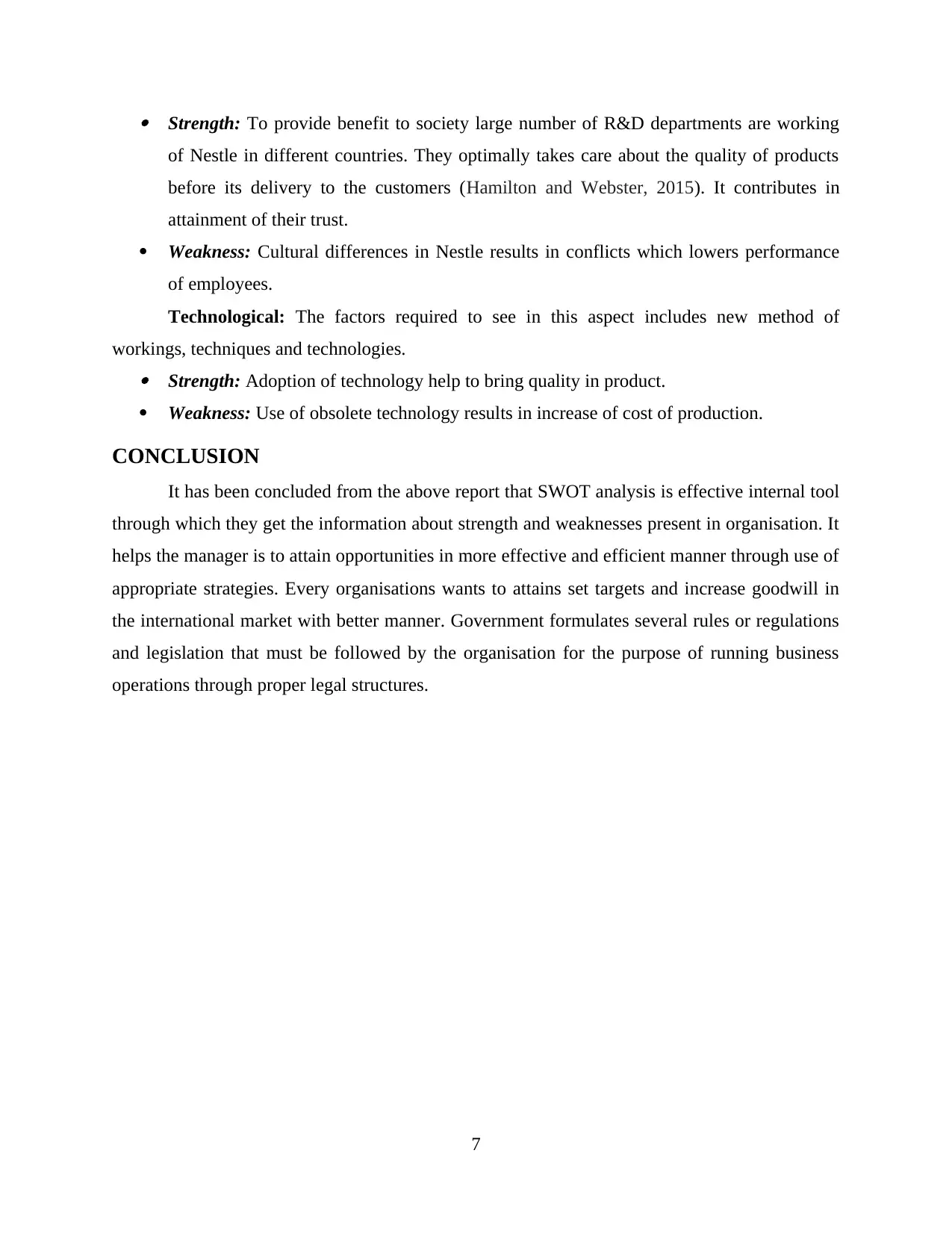
Strength: To provide benefit to society large number of R&D departments are working
of Nestle in different countries. They optimally takes care about the quality of products
before its delivery to the customers (Hamilton and Webster, 2015). It contributes in
attainment of their trust.
Weakness: Cultural differences in Nestle results in conflicts which lowers performance
of employees.
Technological: The factors required to see in this aspect includes new method of
workings, techniques and technologies. Strength: Adoption of technology help to bring quality in product.
Weakness: Use of obsolete technology results in increase of cost of production.
CONCLUSION
It has been concluded from the above report that SWOT analysis is effective internal tool
through which they get the information about strength and weaknesses present in organisation. It
helps the manager is to attain opportunities in more effective and efficient manner through use of
appropriate strategies. Every organisations wants to attains set targets and increase goodwill in
the international market with better manner. Government formulates several rules or regulations
and legislation that must be followed by the organisation for the purpose of running business
operations through proper legal structures.
7
of Nestle in different countries. They optimally takes care about the quality of products
before its delivery to the customers (Hamilton and Webster, 2015). It contributes in
attainment of their trust.
Weakness: Cultural differences in Nestle results in conflicts which lowers performance
of employees.
Technological: The factors required to see in this aspect includes new method of
workings, techniques and technologies. Strength: Adoption of technology help to bring quality in product.
Weakness: Use of obsolete technology results in increase of cost of production.
CONCLUSION
It has been concluded from the above report that SWOT analysis is effective internal tool
through which they get the information about strength and weaknesses present in organisation. It
helps the manager is to attain opportunities in more effective and efficient manner through use of
appropriate strategies. Every organisations wants to attains set targets and increase goodwill in
the international market with better manner. Government formulates several rules or regulations
and legislation that must be followed by the organisation for the purpose of running business
operations through proper legal structures.
7
⊘ This is a preview!⊘
Do you want full access?
Subscribe today to unlock all pages.

Trusted by 1+ million students worldwide
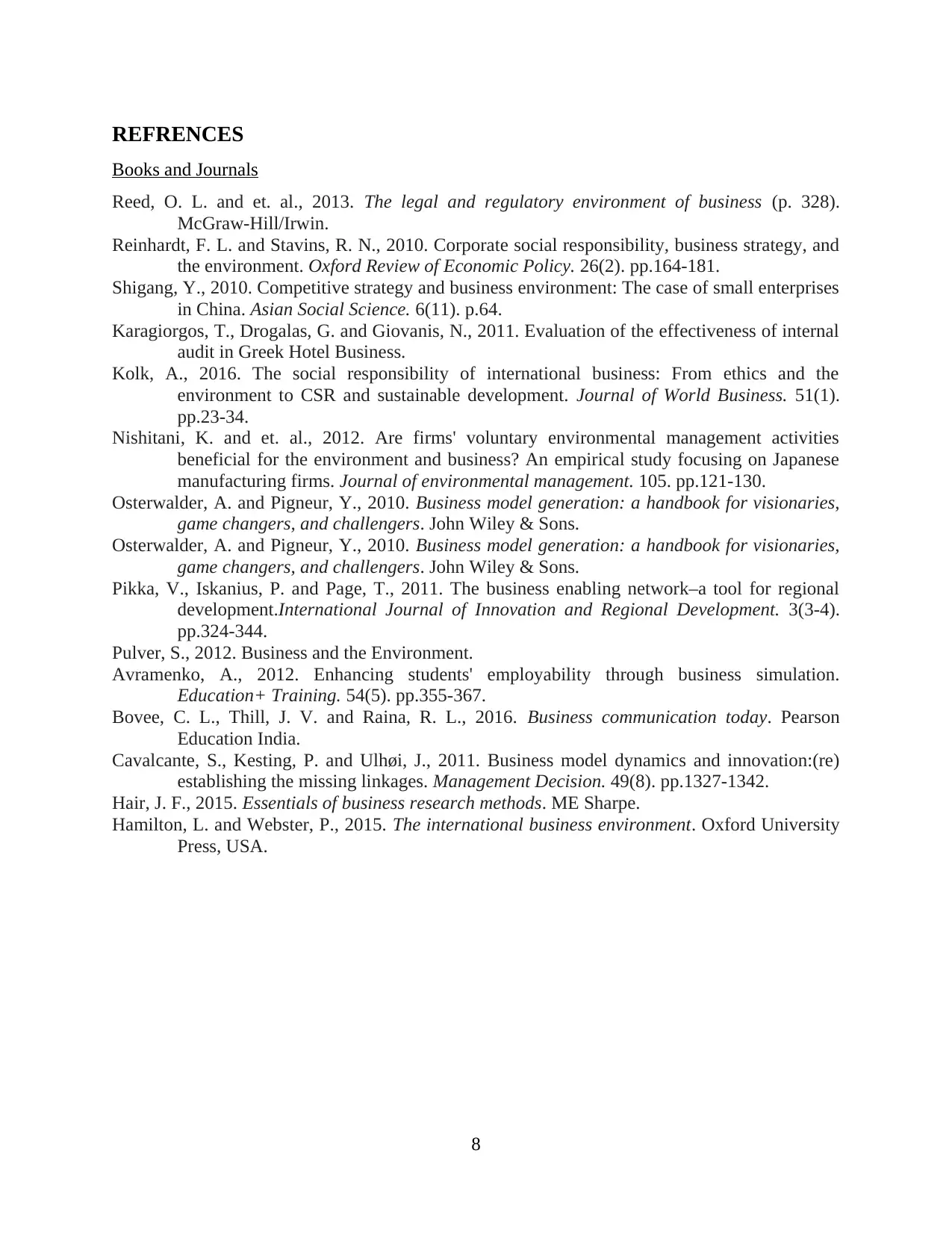
REFRENCES
Books and Journals
Reed, O. L. and et. al., 2013. The legal and regulatory environment of business (p. 328).
McGraw-Hill/Irwin.
Reinhardt, F. L. and Stavins, R. N., 2010. Corporate social responsibility, business strategy, and
the environment. Oxford Review of Economic Policy. 26(2). pp.164-181.
Shigang, Y., 2010. Competitive strategy and business environment: The case of small enterprises
in China. Asian Social Science. 6(11). p.64.
Karagiorgos, T., Drogalas, G. and Giovanis, N., 2011. Evaluation of the effectiveness of internal
audit in Greek Hotel Business.
Kolk, A., 2016. The social responsibility of international business: From ethics and the
environment to CSR and sustainable development. Journal of World Business. 51(1).
pp.23-34.
Nishitani, K. and et. al., 2012. Are firms' voluntary environmental management activities
beneficial for the environment and business? An empirical study focusing on Japanese
manufacturing firms. Journal of environmental management. 105. pp.121-130.
Osterwalder, A. and Pigneur, Y., 2010. Business model generation: a handbook for visionaries,
game changers, and challengers. John Wiley & Sons.
Osterwalder, A. and Pigneur, Y., 2010. Business model generation: a handbook for visionaries,
game changers, and challengers. John Wiley & Sons.
Pikka, V., Iskanius, P. and Page, T., 2011. The business enabling network–a tool for regional
development.International Journal of Innovation and Regional Development. 3(3-4).
pp.324-344.
Pulver, S., 2012. Business and the Environment.
Avramenko, A., 2012. Enhancing students' employability through business simulation.
Education+ Training. 54(5). pp.355-367.
Bovee, C. L., Thill, J. V. and Raina, R. L., 2016. Business communication today. Pearson
Education India.
Cavalcante, S., Kesting, P. and Ulhøi, J., 2011. Business model dynamics and innovation:(re)
establishing the missing linkages. Management Decision. 49(8). pp.1327-1342.
Hair, J. F., 2015. Essentials of business research methods. ME Sharpe.
Hamilton, L. and Webster, P., 2015. The international business environment. Oxford University
Press, USA.
8
Books and Journals
Reed, O. L. and et. al., 2013. The legal and regulatory environment of business (p. 328).
McGraw-Hill/Irwin.
Reinhardt, F. L. and Stavins, R. N., 2010. Corporate social responsibility, business strategy, and
the environment. Oxford Review of Economic Policy. 26(2). pp.164-181.
Shigang, Y., 2010. Competitive strategy and business environment: The case of small enterprises
in China. Asian Social Science. 6(11). p.64.
Karagiorgos, T., Drogalas, G. and Giovanis, N., 2011. Evaluation of the effectiveness of internal
audit in Greek Hotel Business.
Kolk, A., 2016. The social responsibility of international business: From ethics and the
environment to CSR and sustainable development. Journal of World Business. 51(1).
pp.23-34.
Nishitani, K. and et. al., 2012. Are firms' voluntary environmental management activities
beneficial for the environment and business? An empirical study focusing on Japanese
manufacturing firms. Journal of environmental management. 105. pp.121-130.
Osterwalder, A. and Pigneur, Y., 2010. Business model generation: a handbook for visionaries,
game changers, and challengers. John Wiley & Sons.
Osterwalder, A. and Pigneur, Y., 2010. Business model generation: a handbook for visionaries,
game changers, and challengers. John Wiley & Sons.
Pikka, V., Iskanius, P. and Page, T., 2011. The business enabling network–a tool for regional
development.International Journal of Innovation and Regional Development. 3(3-4).
pp.324-344.
Pulver, S., 2012. Business and the Environment.
Avramenko, A., 2012. Enhancing students' employability through business simulation.
Education+ Training. 54(5). pp.355-367.
Bovee, C. L., Thill, J. V. and Raina, R. L., 2016. Business communication today. Pearson
Education India.
Cavalcante, S., Kesting, P. and Ulhøi, J., 2011. Business model dynamics and innovation:(re)
establishing the missing linkages. Management Decision. 49(8). pp.1327-1342.
Hair, J. F., 2015. Essentials of business research methods. ME Sharpe.
Hamilton, L. and Webster, P., 2015. The international business environment. Oxford University
Press, USA.
8
1 out of 10
Related Documents
Your All-in-One AI-Powered Toolkit for Academic Success.
+13062052269
info@desklib.com
Available 24*7 on WhatsApp / Email
![[object Object]](/_next/static/media/star-bottom.7253800d.svg)
Unlock your academic potential
Copyright © 2020–2025 A2Z Services. All Rights Reserved. Developed and managed by ZUCOL.





